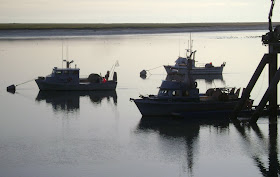
Gillnetters on the Kenai River. Wesley Loy photo
The Department of Fish and Game has posted its
2010 forecast for Upper Cook Inlet sockeye, and it's not very appealing.
Total harvest for all user groups including commercial, sport and dipnet fishermen is projected at 2.3 million fish, with commercial gillnetters to account for most of the catch.
The forecast is way below the 20-year average harvest of 4 million fish.
Last year's tally was 2.6 million.
State biologists expect sockeye runs to the Kenai and Susitna rivers to be well short of historic averages, with the Kasilof River run to nearly match its average.
I don't suppose the decrease in the health of the runs corresponds with the increased levels of tourism/sports fishing in the areas. No one wants to whisper a word about the degradation of the spawning habitat from too many people tromping around in and on it. Hmmmm?
ReplyDeleteI don't suppose ocean productivity comes into the equation anywhere?
ReplyDeleteDon't suppose increased competition from a 10 fold increase in hatchery fish that Alaska pumps into the ocean has anything to do with the "health" of its wild stocks?
Of course not - let's blame habitat degradation like on the Kenai River, where it is estimated that 95% of the habitat degradation noted in 1995 has been restored.
Or let's blame beavers and pike, a common refrain for the Mat-Su ills - of course at the recent Mat-Su Salmon Symposium you would then think Beavers Destroy Northern District Salmon Runs would have been front and center, but alas, hardly a word on the subject.
Probably the tourists.
Its interesting how salmon hatcheries have been getting a lot of attention lately regarding their negative effect on wild salmon runs. The problem with that argument is that salmon hatcheries have been around since 1974 (as far as I know, although there may have been hatcheries earlier) and they have been hatching a fairly consistent number of fish. And over the last 30+ years wild salmon runs have varied from year to year just as they did before hatcheries existed.
ReplyDeleteThough hatcheries are an easy target whenever people start talking about decreasing wild runs, its worth considering that sport fishermen walking over spawning beds all day could be having an effect on the wild salmon.
According to a conversation with a F&G biologist in the Kenai office, we are in the 3rd year of a potential 5 yr slump due to........drum roll please...... over escapement! Science and history shows this to truly be the case but we (commercial fisherman) remain on shore while the dip netters and commercial "river" fisherman demand the huge escapement numbers at the expense of the ecosystem. Want to know where those dip net fish go? Try looking at Craiglook.com, typing in something to do with "wild salmon", "alaska salmon" etc and you'll see folks traveling to Florida, Hawaii etc wanting to barter their "excess" salmon. In the time period between Thanksgiving and New Years, I saw numerous ads from what appears to be vacationers from AK wanting to barter what appears to be "non commercially caught salmon". If the river was managed based on biology instead of "Penny Politics", there'd be plenty for everyone.
ReplyDeleteKenai set netter
Everyone better hope it's just a slump due to a natural rebuilding of the river systems. If it's the same problem the Ayakulik River system and the Karluk River system are dealing with, it is going to be a long time before there is a harvest-able surplus for anyone to squabble over.
ReplyDeleteIn regards to the Kenai, I am sure the low return of Hatchery fish to Hidden Lake was due to over escapement also.
ReplyDeleteRight?
I mean there has to be a brood year interaction at Hidden Lake - oops - I forgot - that has to do with ocean survival, not freshwater conditions.
CIAA didn't get to take eggs this past year, because Hidden Lake didn't make escapement.
Poor Ocean conditions.
What are the "scientists" going to do with claims on the Kenai when the reports come out for mark recapture studies that show about twice as many fish are entering the system as recorded by the sonar counters?
Maybe some more sewage will help.
ReplyDeleteCan't we find some way to blame the "draggers" for this one too? C'mon put on your thinking caps...
ReplyDeleteDoes the ADFG have a management plan for the drager fleet?
ReplyDeleteHow do you find the non target species numbers for the dragers.
From an other blog:How about start by baning dragers from AK state waters.
Thoughts??
UPDATE:
ReplyDeleteWow - the overescapement theory for Kenai River sockeye just got shot in the head with this year's return - and the forecast model based on a brood year interaction...
Again, the Kenia River has never failed to replace itself with any escapement to date...
But let's just ignore that fact and listen to the continuing drum beat from Kenai set netters that it is a real issue.
It is just a trumped up bullshit issue - shit half the sockeye runs in the state go over the upper end of the escapement range, yet only on the Kenai do some drink the overescapement Kool-Aid.